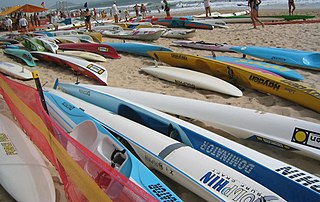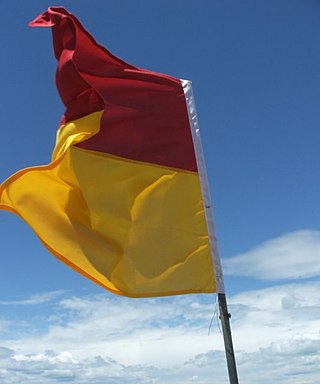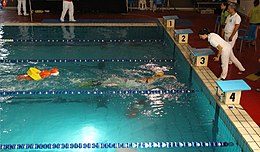
Surf lifesaving is a multifaceted social movement that comprises key aspects of voluntary lifeguard services and competitive surf sport. Originating in early 20th century Australia, the movement has expanded globally to other countries, including New Zealand, Ireland, South Africa, and the United Kingdom. Surf lifesavers in Australia are colloquially known as "Clubbies".

A lifeguard is a rescuer who supervises the safety and rescue of swimmers, surfers, and other water sports participants such as in a swimming pool, water park, beach, spa, river and lake. Lifeguards are trained in swimming and CPR/AED first aid, certified in water rescue using a variety of aids and equipment depending on requirements of their particular venue. In some areas, lifeguards are part of the emergency services system to incidents and in some communities, lifeguards may function as the primary EMS provider.

A surfski is a type of kayak in the kayaking "family" of paddling craft. It is generally the longest of all kayaks and is a performance oriented kayak designed for speed on open water, most commonly the ocean, although it is well suited to all bodies of water and recreational paddling.

Nippers are young surf lifesavers, usually aged between 5 and 14 years old, in clubs across Australia, New Zealand and South Africa. Unlike senior surf lifesavers, the majority of them do not patrol the beaches. The focus for Nippers tends to be on fun, and surf awareness.
The Royal Life Saving Society UK is a drowning prevention charity founded in 1891 in the UK. It has had Royal Patronage since 1904.
Surf Life Saving Northern Region is the largest of four regions that make up Surf Life Saving New Zealand. As of the 2021/2022 season, it is made up of 18 clubs that look after 22 patrol locations from Ahipara to Raglan on the West Coast and from Whangārei Heads to Takapuna on the East Coast.

Surf Life Saving New Zealand (SLSNZ) is the national association representing 74 Surf Life Saving Clubs in New Zealand. The organisation's motto is 'In it for Life'. This refers to both the long relationship many members have with the organisation, as well as to the organisation's purpose of preventing drowning and injury, thereby saving lives.

The International Life Saving Federation (ILS) is an organisation for drowning prevention, water safety, lifesaving and lifesaving sports.

The United States Lifesaving Association is a nonprofit professional association of beach lifeguards and open water rescuers in the United States.

The Royal Life Saving Society Canada, commonly known as the Lifesaving Society or LSS, is a Canadian registered charity that works to prevent water-related injuries through various programs across Canada. The Lifesaving Society is an independent organization that is composed of ten provincial/territorial branches, tens of thousands of individual members, and over 4,000 affiliated swimming pools, waterfronts, schools and clubs. The Society helps prevent drowning and aquatic injury through its training programs, public education, drowning-prevention research, safety management and overseeing the sport of lifesaving. They are one of five nationally recognized first aid training organizations in Canada, alongside the Heart and Stroke Foundation, Red Cross, St. John Ambulance, and the Canadian Ski Patrol.

Surf Life Saving Australia (SLSA) is an Australian not-for-profit community organisation that promotes water safety and provides surf rescue services.

Lifesaving is the act involving rescue, resuscitation and first aid. It often refers to water safety and aquatic rescue; however, it could include ice rescue, flood and river rescue, swimming pool rescue and other emergency medical services. Lifesaving also refers to sport where lifesavers compete based on skills, technique, speed and teamwork. Lifesaving activities specialized in oceanic environment is called surf lifesaving or coastal lifesaving.
Clint David Robinson, OAM is an Australian sprint kayaker and surf lifesaver who has won a complete set of medals at the Summer Olympics.
The ILS World Life Saving Championships are the world championships for lifesaving sport events. They are sanctioned by the International Life Saving Federation (ILS), conducted every 2 years, and formerly marketed and known as the ‘Rescue’ series, for example – Rescue 2008.
The Surf Life Saving Association of Wales (SLSAW) is the national governing body of surf lifesaving in Wales. It is a voluntary, not-for-profit, registered charity organisation. Its goal is "to prevent the loss of life through drowning". The SLSAW organise regional and national competitions—such as the SLSA Wales Stillwater Leagues and the SLSA Wales Ocean Masters Championships – and select and manage the Wales squad for international events, including the Celtic Challenge Cup.
National Water Life Saving Association (NWLSA), also known as Chinese Taipei Water Life Saving Association (CTWLSA), is the major lifesaving organization in Taiwan. The organization's members are mainly volunteer lifesavers, police officers, firefighters and civilians who are enthusiastic about water sports, water safety awareness and water rescue events.

New Zealand is a popular surfing destination, with a long history of the sport and a varied coastline with locations suitable for all types of surfing. The West coast is notably consistent, with big swells and high winds, whereas the east coast is dominated by cyclone season swells; the North island is notably warmer than the South, but less consistent; mean temperatures range from 7 °C to 20 °C, depending on location and time of year. Winter is more consistent than Summer, with a southeasterly swell. The climate of New Zealand is varied, so different surf conditions are encountered across the islands.

Lifesaving South Africa (LSA) is a South African organisation that promotes water safety and provides surf rescue services. LSA is a founding member organisation of the International Life Saving Federation, and a member of Royal Life Saving Society. It is recognised by DSAC and SASCOC.
Simon Lewis is an Australian lifeguard and volunteer surf lifesaver. Once the former St Kilda Lifesaving Club Captain, he is the only Australian lifeguard to have worked both major migration routes in Europe. He first became part of a team of six on lesvos Greece with International Surf Lifesaving Association (ISLA). Since joining the mission with ISLA, Lewis has completed seven humanitarian rescue missions with six NGOs saving the lives of over 1,900 African and Syrian refugees as they attempted to cross the dangerous waters of the Mediterranean Sea to Greece and Italy. As well as being the first Australian to become the head of mission on the central migration route for the German NGO Mission Lifeline, Lewis participated in the Asylum Seeker Resource Centre (ASRC) yearly telethon which raised over $800,000 for the organisation to continue to help those in dire need.













